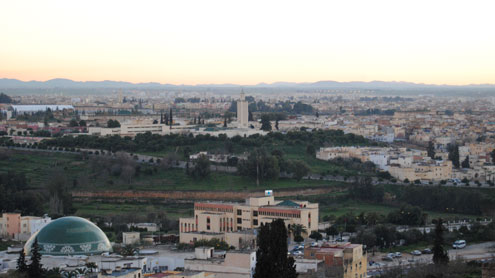Nobody passing the little brick structure on their way to Lloyd Hall Monday morning knew it marked what used to be one of the most important historical sites on campus.
Why would they? It doesn’t look like much; a stubby brick thing sticking out of the Quad like an overgrown anthill just east of Gorgas. Some of the bricks have flaked off, exposing a cinderblock skeleton, a home to cigarette butts and hornet nests.
“It’s ugly,” said student Stephnye Smith. “I just thought it was some random bricks from the Civil War or something.”
Even the archaeologists were stumped. It couldn’t be very old, said professor Matthew Gage, 1970s at the earliest – well out of range of a department that specializes in Alabama’s most ancient civilizations.
It took Robert Mellown, an art history professor and expert on UA architecture, to finally identify it as the marker for the site of Madison Hall, an antebellum dormitory burned by Union troops in 1865.
The site is not the Historic Mound. The Mound is the ruin of Franklin Hall; it is above ground, labeled, and protected from tailgaters, while the only thing left of Madison Hall is the crumbling brick edifice constructed by Jerry Oldshue and his team in 1975, when they excavated the site for the first time.
“It’s almost like unwrapping a Christmas present,” Oldshue said, describing the process of opening the Quad layer-by-layer to unearth historical trinkets.
They found mostly domestic trivia like spoons, desk frames or coffee pots, but according to Oldshue, even mundane things can give valuable insight. The iron window weights, which fell straight down as the structure burned, allowed the archaeologists to determine the exact boundaries of the building and construct a layout of the rooms.
But the relics weren’t without their curiosities. The excavations uncovered a Derringer pistol, bits of a porcelain doll, a sword hilt and the Hindu goddess Shiva – a statue sent to a resident preacher by his missionary friend.
“It took us about four years to figure that one out,” Oldshue said.
Oldshue said the campus is covered in the buried foundations of antebellum buildings, but Madison is one of the largest and most accessible sites.
“It was just easier to go back to the one you knew,” Oldshue explained.
Madison’s final excavation took place in 1990 during homecoming weekend, and the site was open for quad-goers to see along with a display of relics. It was even featured in the New York Times.
But as Oldshue and the rest of the project’s enthusiasts retired or moved on from UA, Madison was slowly forgotten. Oldshue commissioned student metal workers to make a historical marker, but they botched the job and he didn’t get funding for another one.
Now the bricks are the only things left.
“Maybe it’ll get a sign on it one of these days,” Oldshue said.
The campus is littered with bits of forgotten history, be it in foundations like the Madison site, filled-in wells near Clark, or the old cemetery behind the Biology building. Mellown wrote a book about UA’s architectural history, titled “The University of Alabama: A Guide to the Campus.” The book is out of print, but Mellown plans to release a larger version next year.
“I hope it will promote awareness of the campus’s interesting history,” he said. “It is amazing how quickly people forget about the past.”
(For more information about Madison Hall, check out “The University of Alabama; A Pictoral History” by Rau Wolfe.)









